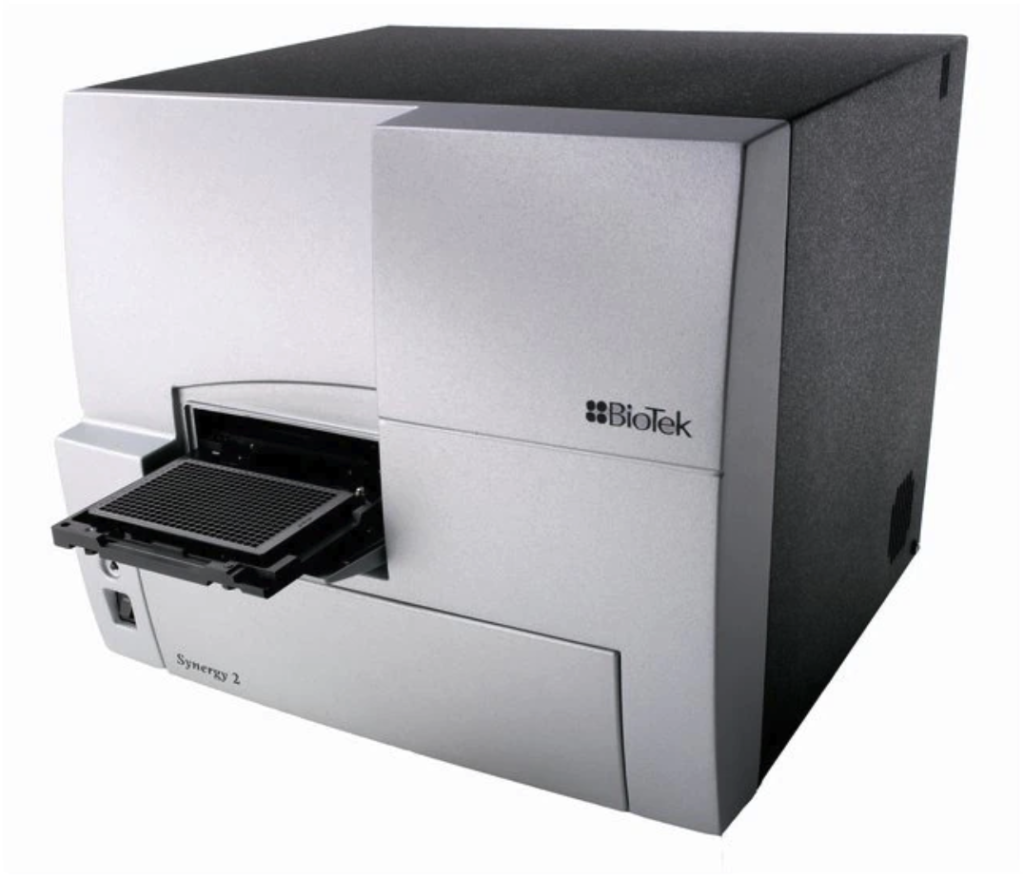By Nathan Seals
Fun rating: 5/5

Difficulty rating: 1/5

Why do we use it?
Optical density measurements are used to calculate the number of cells (bacteria in the example below) in a liquid culture (a soup of cells and the nutrients they need to grow). These measurements can be taken over time to measure how fast the cells are dividing.
How does it work?
Measuring optical density (OD) of a bacterial culture relies on the physics of how light travels through liquid.
Materials:
- Laser (typically yellow)
- Detector
- Liquid bacterial culture
- Vessel (something to hold your bacterial culture)
- The laser shines through the vessel. The vessel contains the bacterial culture being measured.
- The detector “sees” how much light makes it through the culture. The detector is connected to a computer that can interpret what the detector is sensing.
- The computer spits out numbers that we can understand and interpret. The more bacteria there are in the liquid, the higher the number will be.
Generally, bacterial OD is measured using a yellow laser. It was found that yellow light with a wavelength of 600 nanometers (nm) works the best; thus, we usually call this measurement optical density at 600 nm or OD600.
Bacterial OD is measured by a few different types of machines but they generally rely on the same physics principles to function. The main thing that changes between these machines is the amount of bacterial culture that they require to take a measurement and how much bacterial culture is lost in the process of taking the measurement. Below are three common ways of measuring optical density.
- Microplate reader: One of the many things this machine can be used for is measuring OD600. The microplates that this machine uses are small, plastic trays, about the size of a deck of cards. The plates have holes (wells) in them that hold liquid. The benefit of this machine is that you can run many experiments at once on a single plate. The bacteria can also be grown in the plate, so you don’t lose any sample by taking an OD reading. Better still, most new plate readers have everything needed to actually grow your bacteria! You don’t need to do anything but press a button and the computer handles the rest!

- Traditional Spectrophotometer: This machine is the least sophisticated and least flexible machine of the three. That said, it is still considered to be the gold standard for OD600 readings. It utilizes small plastic tubes called cuvettes that hold the bacterial culture. The main difference here is that cuvettes are thick. This causes the laser to travel further through the liquid. A longer distance traveled by the laser leads to more reliable readings. Unfortunately, the cuvettes don’t have lids so they also aren’t very clean. The sample used to measure OD600 in a cuvette cannot be added back to the culture, so the sample used for the OD reading is lost.

- Nanodrop: The nanodrop is a type of spectrophotometer that requires wasting less sample. It works by shining its yellow laser through a very small drop of your bacterial culture which has been placed on a small metal pedestal (no tube or cuvette needed!). The pedestal is not very clean, so the sample cannot be placed back into the original culture. However, only a tiny drop is used out of our much larger bacterial culture. This means that we have plenty for other experiments later!
Why do we measure OD600?
OD600 is usually used to track the growth of cells (often bacterial cells) over time. We use it to figure out if certain chemicals or genetic mutations affect cell growth. Data collected from these sorts of experiments can help us understand how certain genes contribute to bacteria’s ability to cause disease or can even be used to discover new antibiotics!
References
Beal, J., Farny, N.G., Haddock-Angelli, T. et al. Robust estimation of bacterial cell count from optical density. Commun Biol 3, 512 (2020). https://doi.org/10.1038/s42003-020-01127-5
